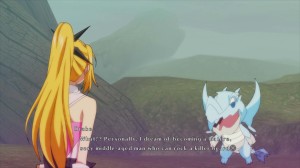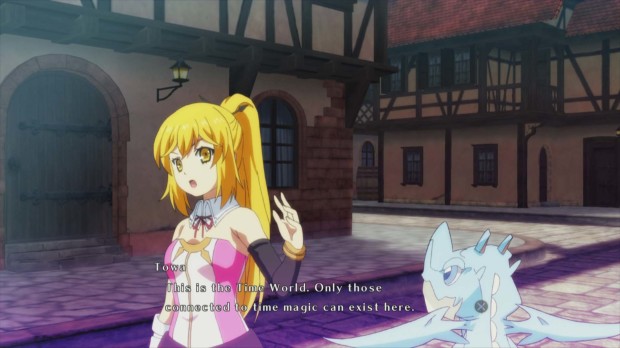Hands-On with Time and Eternity
At E3 this year, I had the opportunity to get my hands on something hitting the market on July 16, 2013: Time and Eternity, from Imageepoch. Sporting an interesting graphical art style and a unique set of RPG mechanics, will the title be another JRPG hit, or will it fall short? Let’s take a glance at how it’s looking so far.
Originally released last October in Japan, in Time and Eternity (TaE) you will be playing as Zack, a man who is killed on his wedding day by an unknown group of assassins. Seeking vengeance and answers, your betrothed Toki unleashed her meaner alter ego, Towa. She then sets out on a quest through time using her hidden power to find your assassin, discover why you were killed, and either avenge you or prevent your death. You’ll be joining her too, as your spirit is reincarnated in the body of a small blue dragon! Not much else is known about the story besides that, so we’ll have to reserve any opinions for the launch of the full title.
The demo I played placed me somewhere that I’m guessing was close to the beginning of the game, as I only had the first few abilities available to me. Starting in a beautiful green plane, my goal was to meet up with a little girl, and help her find her missing hamsters. It was not the most glorious task to undertake, and I doubt the bards would sing of my rodent-saving exploits (though “ode to the hamster lord” would make for some great listening), but the quest served two key purposes. First, it prevented any plot revelations that would potentially ruin replaying that chapter when TaE is released, and secondly, it allowed me to run to various ends of the map and take part in several battles so I could get a better idea of the combat system, and what I would be getting myself into.
 Speaking of which, TaE features a very interesting and engaging battle system. While the story may revolve around the reborn dragon protagonist, players can also take control of Toki and Towa for gameplay – with each having their own personality and stats. Towa is a close-quarters brawler, while Toki would rather sit back and shoot her gun, or sling spells at her enemies. The character you play as is dependent upon your level, as at every level-up you swap characters – generally seeing Toki on odd numbered levels and Towa on even. Asking a NIS rep about this system, and the potential to switch at other places, I was informed that aside from level-ups, certain items will allow gamers to switch between Toki and Towa – presumably using up the item. Whether this system for switching characters will create an interesting need to play carefully and tactically, or put a damper on your personal playstyle will only be answered at launch.
Speaking of which, TaE features a very interesting and engaging battle system. While the story may revolve around the reborn dragon protagonist, players can also take control of Toki and Towa for gameplay – with each having their own personality and stats. Towa is a close-quarters brawler, while Toki would rather sit back and shoot her gun, or sling spells at her enemies. The character you play as is dependent upon your level, as at every level-up you swap characters – generally seeing Toki on odd numbered levels and Towa on even. Asking a NIS rep about this system, and the potential to switch at other places, I was informed that aside from level-ups, certain items will allow gamers to switch between Toki and Towa – presumably using up the item. Whether this system for switching characters will create an interesting need to play carefully and tactically, or put a damper on your personal playstyle will only be answered at launch.
As for the actual battle itself, TaE employs a combination of real-time attacking with list-based commands. Players may freely attack with basic combos at any point, with no need to wait for a time gauge. Dependent upon your strategy, there are two positions you can fight in on the battlefield: close up and far away. You may freely switch between these positions, and your enemy can do the same. For example, you may both be a far end, battling close-quarters. You decide you need some distance and jump back to the closer position (i.e. your own side), turning it into a ranged match. Unfortunately though, the enemies I encountered seem to dislike this, and tended to jump forward as well, boxing me in – which is where combat got interesting. Since I was at the closer position, I could no longer gain that range unless I found a way to knock my foe back – which your opponents can do if boxed in as well. This may sound kind of confusing, but once you see it in action it’s as simple as cheese and crackers.
 As mentioned above, you can attack rapidly without any hindrance to string together combos, but your attack will differ depending upon your distance from your foe. Should you be fighting up close on either side of the battlefield, your character (regardless of current form, Toki or Towa) will use his/her combat knife to furiously hack away at your foes. Should you be on opposite ends of the field, you will fire off several shots from your trusty rifle. Each attack you land adds sections to your ability gauge, and after amassing a certain amount you can unleash various special moves. The skills you can use are assigned outside of combat, and are presumably unlocked as you level up and progress. These powers can range from a flurry of flips and slashes with your blade (which will miss if you’re not up close), powerful magic spells like lightning strikes, or temporary attack and defense buffs. As for defense, if you have fast enough reflexes, you can flick the left thumbstick to the left in order to flip out of the way. Time it right, and you’ll avoid the attack. Get it wrong, however, and you’ll just waste your time. If you’re in a pinch and need an item, simply press the item button for a drop down menu, which pauses the battle and allows you to select the tool you need.
As mentioned above, you can attack rapidly without any hindrance to string together combos, but your attack will differ depending upon your distance from your foe. Should you be fighting up close on either side of the battlefield, your character (regardless of current form, Toki or Towa) will use his/her combat knife to furiously hack away at your foes. Should you be on opposite ends of the field, you will fire off several shots from your trusty rifle. Each attack you land adds sections to your ability gauge, and after amassing a certain amount you can unleash various special moves. The skills you can use are assigned outside of combat, and are presumably unlocked as you level up and progress. These powers can range from a flurry of flips and slashes with your blade (which will miss if you’re not up close), powerful magic spells like lightning strikes, or temporary attack and defense buffs. As for defense, if you have fast enough reflexes, you can flick the left thumbstick to the left in order to flip out of the way. Time it right, and you’ll avoid the attack. Get it wrong, however, and you’ll just waste your time. If you’re in a pinch and need an item, simply press the item button for a drop down menu, which pauses the battle and allows you to select the tool you need.
This battle system made TaE one of my most memorable stops at E3, as it combines many different types of gameplay to create one interesting experience. While devilishly simple, the implications and possibilities of the combat mechanics make it very addictive and easy to pick up. After just a few minutes I felt as though I knew all the basics to get me by, yet still felt as though I had a lot to learn and practise. Adding to this simple joy is how different the game feels from any other JRPG. Many gamers who pick up TaE will probably have played several games in the genre before it, and this title does a fantastic job of keeping it feeling fresh and entertaining. There is still a lot yet to be seen, and it’s still uncertain how well these features will hold up after 10+ hours, but so far TaE’s gameplay is shaping up to be something great.
Another feature to set the title apart from its RPG brethren is its graphical approach. Instead of using straight CG characters (like in Final Fantasy or Kingdom Hearts), or even using cel- shaded 3D models (à la Tales of Vesperia or Ni no Kuni: Wrath of the White Witch), the developer chose instead to present all the characters and cutscenes in-game through 2D hand-drawn anime produced by Satelight (Persona 2). The game still uses 3D modeling for the environment and buildings, while people and monsters are placed over top of these backdrops as 2D pictures. This creates a very interesting visual effect that you don’t see very often, where gamers are literally playing an anime. This graphical setup leads to some fascinating and beautiful animations and incredible fight scenes – not to mention the fact that it gives interaction with NPCs some extra visual flair.
Everything about Time and Eternity has so far been presented in very unique and interesting ways, from the simple-yet-engaging gameplay, to the hand drawn art style. While there is still a lot to see in the coming days, this is definitely one JRPG that genre fans need to keep an eye on. Time and Eternity launches exclusively on the PlayStation 3 on July 16, 2013. Stay tuned for a full review coming your way soon!
About This Post
